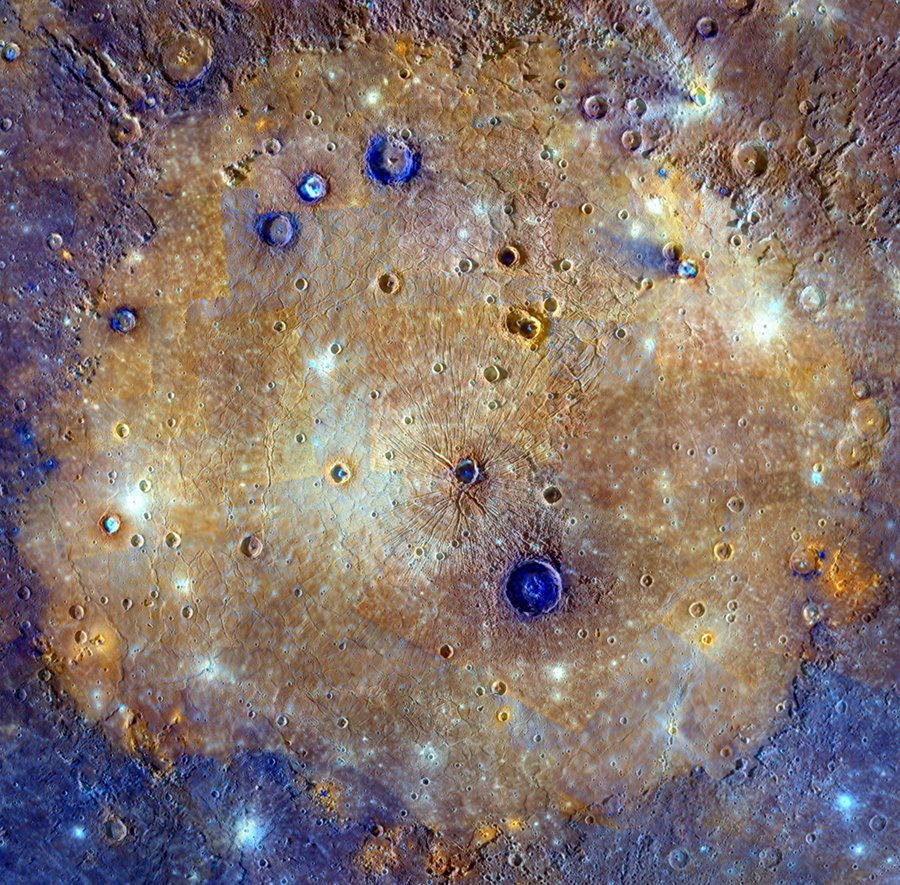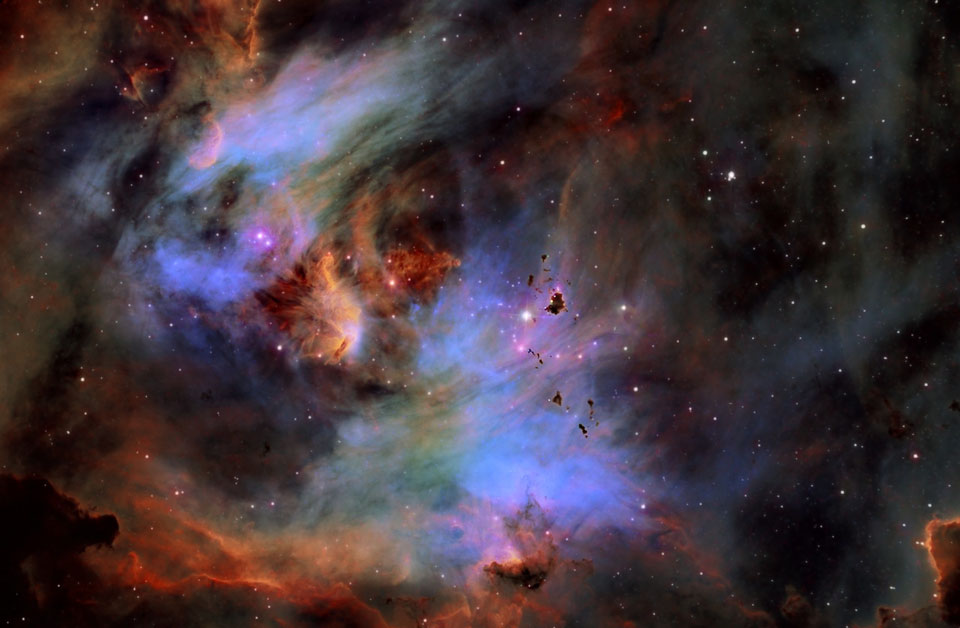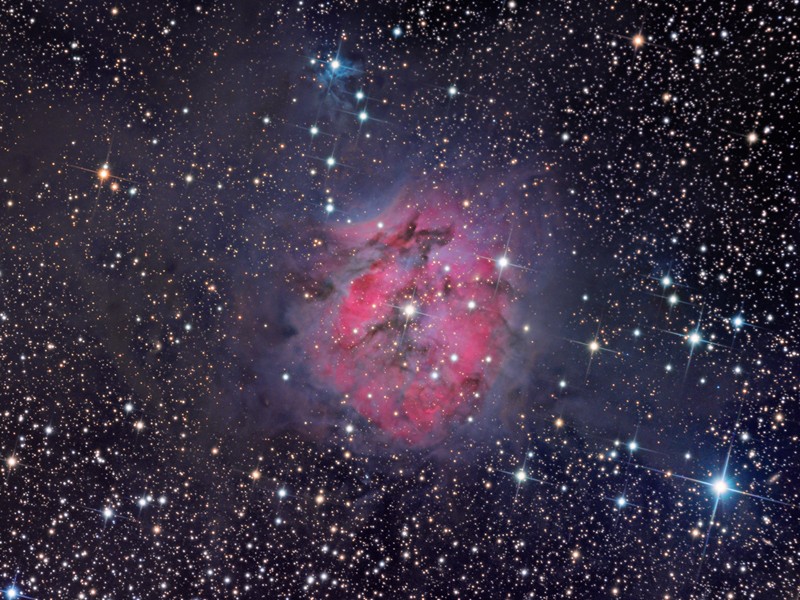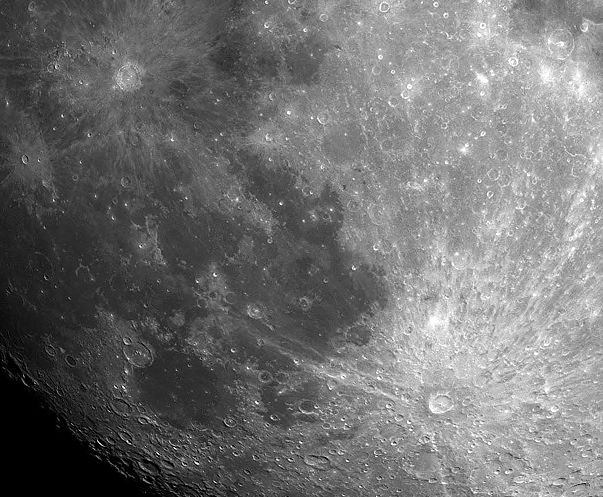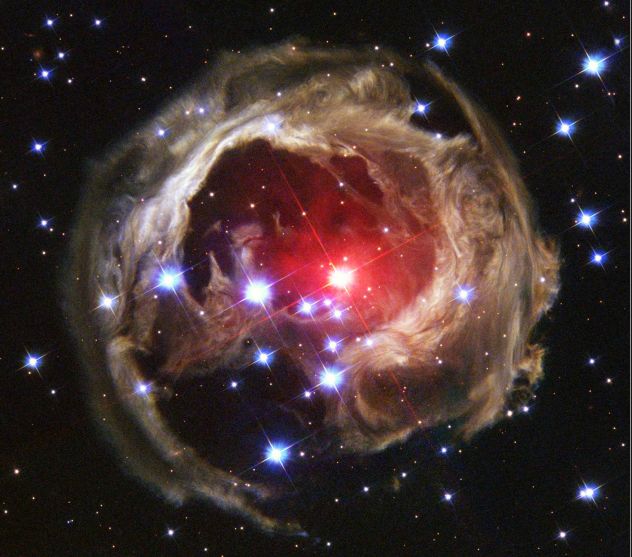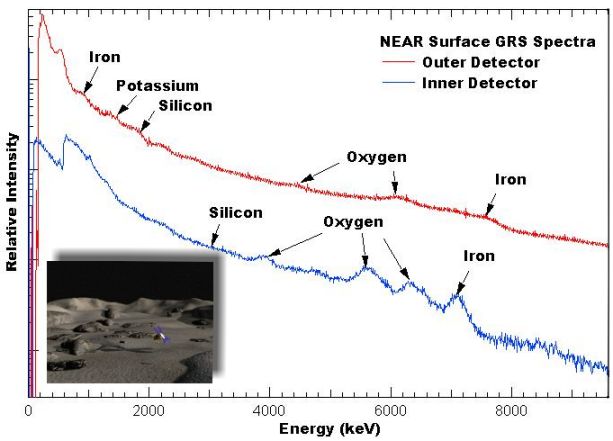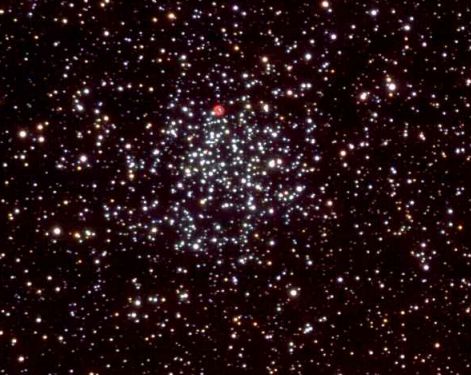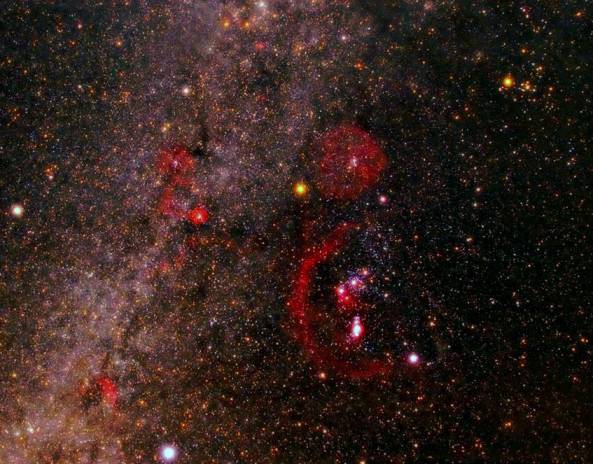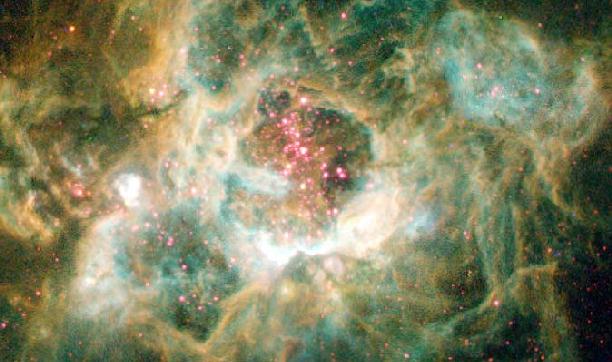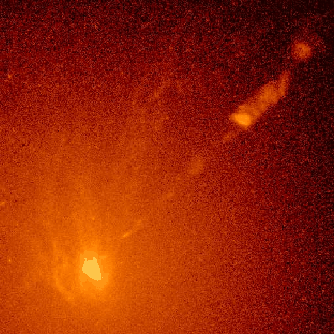| << Previous | Index | Next >> |
2015 The sprawling Caloris basin on Mercury is one of the solar system's largest impact basins, created during the early history of the solar system by the impact of a large asteroid-sized body. The multi-featured, fractured basin spans about 1,500 kilometers in this enhanced color mosaic based on image data from the Mercury-orbiting MESSENGER spacecraft. Mercury's youngest large impact basin, Caloris was subsequently filled in by lavas that appear orange in the mosaic. Craters made after the flooding have excavated material from beneath the surface lavas. Seen as contrasting blue hues, they likely offer a glimpse of the original basin floor material. Analysis of these craters suggests the thickness of the covering volcanic lava to be 2.5-3.5 kilometers. Orange splotches around the basin's perimeter are thought to be volcanic vents.
2014 The eggs from this chicken may form into stars. The above pictured emission nebula, cataloged as IC 2944, is called the Running Chicken Nebula for the shape of its greater appearance. The image was taken recently from Siding Spring Observatory in Australia and presented in scientifically assigned colors. Seen near the center of the image are small, dark molecular clouds rich in obscuring cosmic dust. Called Thackeray's Globules for their discoverer, these "eggs" are potential sites for the gravitational condensation of new stars, although their fates are uncertain as they are also being rapidly eroded away by the intense radiation from nearby young stars. Together with patchy glowing gas and complex regions of reflecting dust, these massive and energetic stars form the open cluster Collinder 249. This gorgeous skyscape spans about 70 light-years at the nebula's estimated 6,000 light-year distance.
2013
[imghover6=http://apod.nasa.gov/apod/image/1303/le ... ky_960.jpg]http://apod.nasa.gov/apod/image/1303/le ... ed_960.jpg[/imghover6]Image Credit & Copyright: Yuri Beletsky (ESO)
2012
Click to play embedded YouTube video.
Video Credit: Gateway to Astronaut Photography, NASA; Compilation: Bitmeizer; Music: Freedom Fighters (Two Steps from Hell)
2011
2010 The plane of our Milky Way Galaxy runs right through Auriga, the Charioteer. A good part of the ancient northern constellation's rich collection of nebulae and star clusters is featured in this expansive, 10 degree wide skyscape. Bright star Elnath lies near the bottom right, linking Auriga to another constellation, Taurus, the Bull. Three open star clusters, Charles Messier's M36, M37, and M38 line up in the dense star field above and left of Elnath, familiar to many binocular-equipped skygazers. But the deep exposure also brings out the reddish emission nebulae of star-forming regions IC 405, IC 410, and IC 417. E. E. Barnard's dark nebulae B34 and B226 just stand out against a brighter background. For help identifying even more of Auriga's deep sky highlights, put your cursor over the image.
2009 Inside the Cocoon Nebula is a newly developing cluster of stars. Cataloged as IC 5146, the beautiful nebula is nearly 15 light-years wide, located some 4,000 light years away toward the northern constellation Cygnus. Like other star forming regions, it stands out in red, glowing, hydrogen gas excited by young, hot stars and blue, dust-reflected starlight at the edge of an otherwise invisible molecular cloud. In fact, the bright star near the center of this nebula is likely only a few hundred thousand years old, powering the nebular glow as it clears out a cavity in the molecular cloud's star forming dust and gas. This exceptionally deep color view of the Cocoon Nebula traces tantalizing features within and surrounding the dusty stellar nursery.
2008 The developing International Space Station (ISS) has changed its appearance again. Last month, the Space Shuttle orbiter Atlantis visited the ISS and added components that included the Columbus Science Laboratory. The entire array of expansive solar panels is visible in this picture taken by the Atlantis Crew after leaving the ISS to return to Earth. The world's foremost space outpost can be seen developing over the past several years by comparing the above image to past images. Also visible above are many different types of modules, a robotic arm, another impressive set of solar panels, and a supply ship. Construction began on the ISS in 1998.
2007 What's happening to the galaxies of cluster Abell 2667? On the upper left, a galaxy appears to be breaking up into small pieces, while on the far right, another galaxy appears to be stretched like taffy. To start, most of the yellowish objects in the above image from the Hubble Space Telescope are galactic members of a massive cluster of galaxies known as Abell 2667. The distortion of the galaxy on the upper left is real. As the galaxy plows through the intercluster medium, gas is stripped out and condenses to form bright new knots of stars. This detailed image of ram pressure stripping helps astronomers understand why so many galaxies today have so little gas. The distortion of the galaxy on the far right, however, is an illusion. This nearly normal galaxy is actually far behind the massive galaxy cluster. Light from this galaxy is gravitationally lensed by Abell 2667, appearing much like a distant person would appear through a wine glass. Each distorted galaxy gives important clues about how galaxies and clusters of galaxies evolve.
2006 How can an aurora appear so near the ground? Pictured above are not aurora but nearby light pillars, a local phenomenon that can appear as a distant one. In most places on Earth, a lucky viewer can see a Sun-pillar, a column of light appearing to extend up from the Sun caused by flat fluttering ice-crystals reflecting sunlight from the upper atmosphere. Usually these ice ice crystals evaporate before reaching the ground. During freezing temperatures, however, flat fluttering ice crystals may form near the ground in a form of light snow, sometimes known as a crystal fog. These ice crystals may then reflect ground lights in columns not unlike a Sun-pillar. In the above picture, the colorful lights causing the light pillars surround a ice-skating rink in Fairbanks, Alaska.
2005 Dazzling in binoculars or a small telescope, the Moon is pocked with impact craters. During partial lunar phases, the craters along the terminator are cast in dramatic relief by strong shadows. But when the Moon is full some craters seem to sprout systems of bright radial lines or rays. This detailed close-up of the full Moon features two prominent ray craters, Copernicus (upper left) and Tycho (lower right), each with extensive ray systems of light colored debris blasted out by the crater-forming impacts. In general, ray craters are relatively young as their rays overlay the lunar terrain. In fact, at 85 kilometers wide, Tycho, with its far reaching rays, is the youngest large crater on the nearside. Crater Copernicus, surrounded by dark mare which contrast nicely with its bright rays, is 93 kilometers in diameter.
2004 Variable star V838 Monocerotis lies near the edge of our Milky Way Galaxy, about 20,000 light-years from the Sun. Still, ever since a sudden outburst was detected in January 2002, this enigmatic star has taken the center of an astronomical stage while researchers try to understand where it fits into the picture of stellar evolution. As light from the stellar flash echoes across pre-existing dust shells around V838 Mon, its appearance changes dramatically. Revealed in a sharp snapshot recorded in February by the Hubble's Advanced Camera for Surveys, this portion of the dust shell is about six light-years in diameter. But because light reflected from the dust follows only a slightly indirect path compared to the direct line-of-sight to the star, the light echoes visible now are only lagging about two years behind the outburst itself. Astronomers expect the expanding echoes to continue to light up the dusty environs of V838 Mon for at least the rest of the current decade.
2003 Where do people live on Planet Earth? Although people inhabit every continent, the highest population densities occur in Asia. Sparsely inhabited regions occur on virtually every continent, however, including the Sahara Desert in Africa, the Great White North of North America, the outback of Australia, the Amazon of South America, and the Himalayan Mountains of Asia. The above color-coded map was produced from populations estimates made for 1994, when the world population was about 5.5 billion. Current estimates place the world population at about 6.3 billion.
2002 Here are the true colors of planet Earth. Blue oceans dominate our world, while areas of green forest, brown mountains, tan desert, and white ice are also prominent. Oceans appear blue not only because water itself is blue but also because seawater frequently scatters light from a blue sky. Forests appear green because they contain chlorophyll, a pigment that preferentially absorbs red light. The above image is a composite generated predominantly with data from Moderate Resolution Imaging Spectroradiometer (MODIS), an instrument mounted on the Terra satellite that has orbited Earth since 1999 December. Sub-areas were imaged only when experiencing cloud-free daylight when it occurred from June through September 2001. The Earth looks much different at night.
2001 Not part of a television game series, the NEAR Shoemaker spacecraft survived its unprecedented landing on an asteroid last month. As suggested in the illustration inset above, the car-sized probe likely rests gently on the tips of its solar panels having touched down under the influence of asteroid Eros' feeble gravity. Fortunately, the spacecraft's solar panels were bathed in sunlight and able to power NEAR's gamma-ray spectrometer. Perched on the asteroid, this instrument can determine the composition of Eros to a depth of about 10 centimeters with unanticipated accuracy by measuring the gamma-ray signatures of the atomic nuclei present. The data returned from the surface of Eros are plotted above and show clearly features corresponding to Iron, Oxygen, Silicon, and Potassium in the asteroid's regolith. Also briefly operating on Eros, NEAR's magnetometer has indicated that no surface magnetic field is discernible. Now turned off, NEAR Shoemaker could remain preserved in its present location, the vicinity of the huge, saddle-shaped feature dubbed Himeros, for billions of years. But, as the asteroid orbits, the spacecraft's solar panels will be repeatedly turned toward the Sun ... offering the possibility of reawakening this survivor.
2000 The dark nebula predominant at the lower left of the above photograph is known as the Pipe Nebula. The dark clouds, suggestively shaped like smoke rising from a pipe, are caused by absorption of background starlight by dust. These dust clouds can be traced all the way to the Rho Ophiuchi nebular clouds on the right. The brightest star in the field is Antares. Many types of nebula are highlighted here: the red are emission nebula, the blue are reflection nebula, and the dark are absorption nebula. This picture has been digitally enhanced.
1999 Galactic or open star clusters are relatively young. These swarms of bright stars are born near the plane of the Milky Way, but their numbers steadily dwindle as cluster members are strewn through the Galaxy by gravitational interactions. This bright open cluster, known as M46, is around 300 million years young and still contains a few hundred stars. Located about 5,000 light-years away toward the constellation Puppis, M46 is a familiar object to telescopic stargazers and also seems to contain a contradiction to its youthful status. The striking red patch of glowing gas above center in this lovely photograph is the planetary nebula NGC 2438 - a brief, final phase in the life of a solar-type star a few billion years old whose central reservoir of hydrogen fuel has been exhausted. In fact, NGC 2438 is estimated to be only 3,000 light-years distant and moves at a different speed than M46 cluster members. It likely represents a foreground object, only by chance appearing along our line of sight to young M46.
1998 This gorgeous view of stars, nebulae, and the Milky Way comes from the dark night sky above the lovely island of La Palma in the Canaries archipelago. The picture was made by a group of experienced astrophotographers who traveled there to take advantage of the ideal observing conditions near La Palma's Observatorio del Roque de los Muchachos. Skygazers can easily pick out several of their favorite astronomical objects in this wide angle time exposure which covers about 40 degrees on winter the sky. Faint stars along the plane of our Galaxy compose the delicate, luminous band of the Milky Way stretching across the image from the bottom left. The familiar constellation of Orion the hunter is also easy to find, with glowing nebulae highlighting the hunter's belt and sword. Orion's famous red giant star Betelgeuse, near picture center, has a yellowish cast and Rigel is the bright star in Orion at lower right. Brilliant white Sirius, near the bottom, is the brightest star in the picture (and in Earth's night sky). Sirius, is part of the constellation Canis Major (Big Dog). Across the Milky Way, above and to the left of Sirius, is slightly less brilliant Procyon, brightest star of Canis Minor. A V-shaped group of yellowish stars at the upper right, part of Taurus the bull, is dominated by the red giant Aldebaran.
1997 Stars are sometimes born in the midst of chaos. About 3 million years ago in the nearby galaxy M33, a large cloud of gas spawned dense internal knots which gravitationally collapsed to form stars. But NGC 604 was so large, it could form enough stars to make a globular cluster. Many young stars from this cloud are visible above, along with what is left of the initial gas cloud. Some stars were so massive they have already evolved and exploded in a supernova. The brightest stars that are left emit light so energetic that they create one of the largest cloud of ionized hydrogen gas known, second only to the 30 Doradus Cluster in Milky Way's close neighbor, the Large Magellanic Cloud.
1996 The center of nearby giant galaxy M87 is a dense and violent place. In this 1994 photograph by the Hubble Space Telescope, a disk of hot gas was found to be orbiting at the center of this massive elliptical galaxy. The disk is evident on the lower left of the above photograph. The rotation speed of gas in this disk indicates the mass of the object the gas is orbiting, while the size of the disk indicates an approximate volume of the central object. These observations yield a central density so high that the only hypothesized object that could live there is a black hole. The picture also shows a highly energetic jet emanating from the central object. The jet is composed of fast moving charged particles and has broken into knots as small as 10 light years across.
| << Previous | Index | Next >> |
